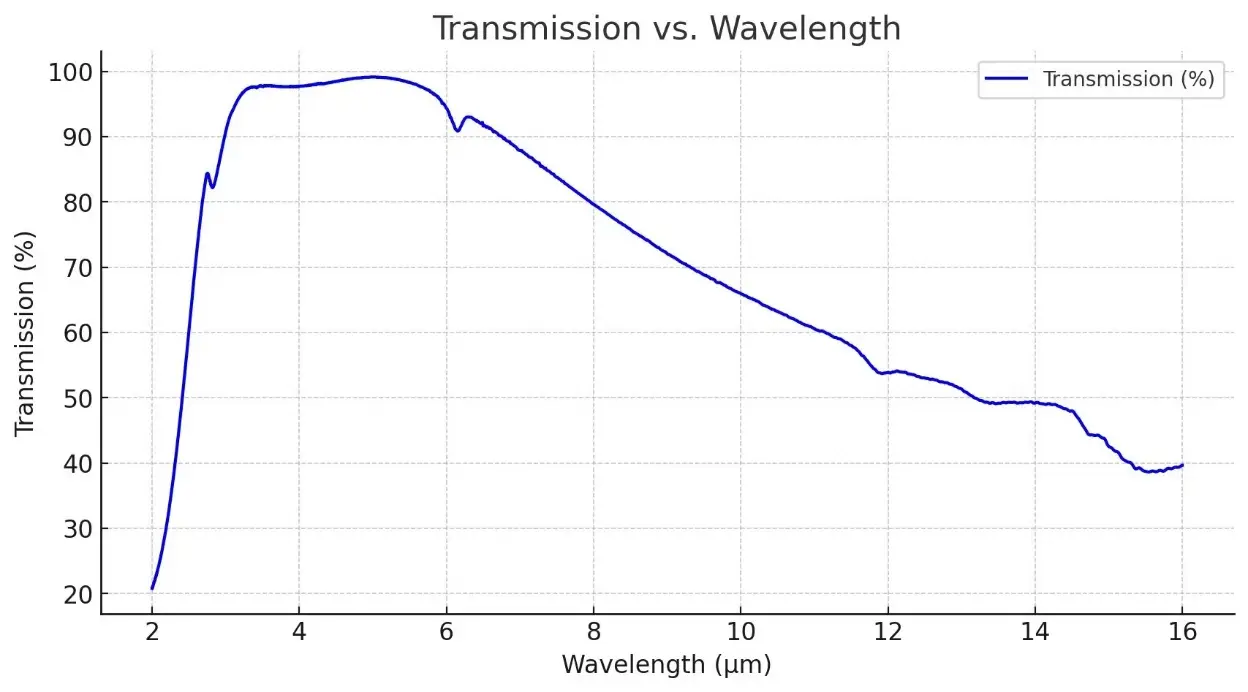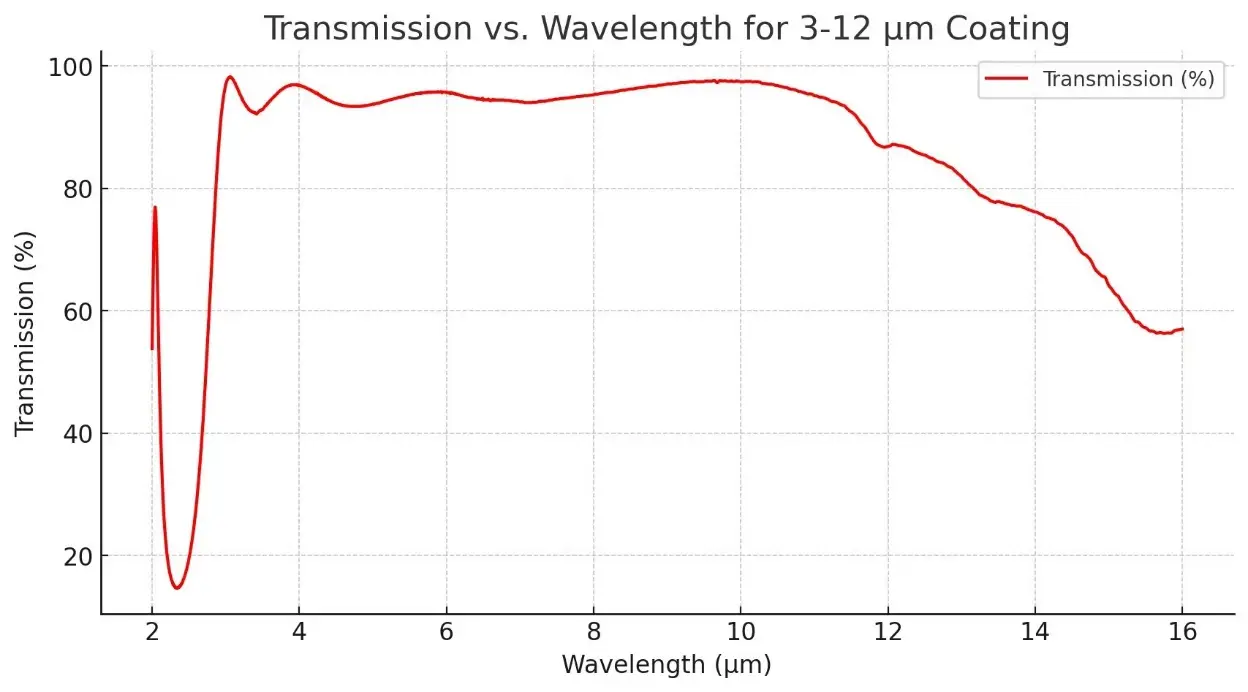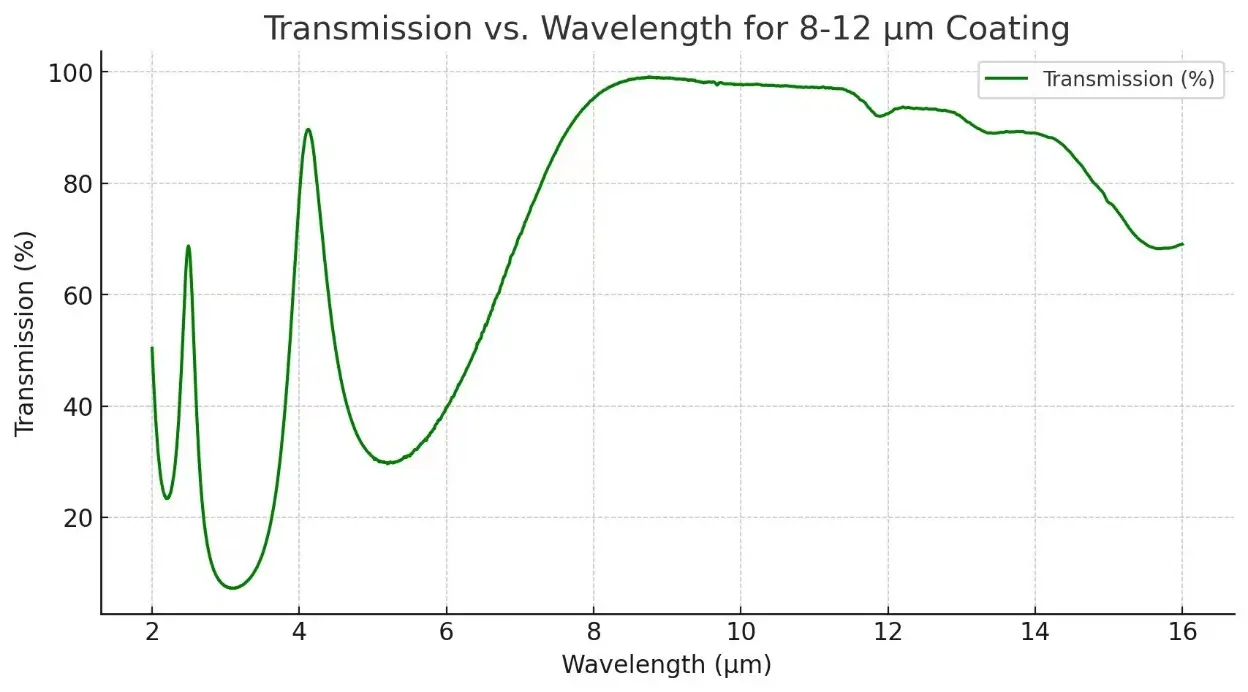Description:
Germanium windows offer superior transmission capabilities in the 2-14 µm waveband, making them suitable for both mid-wave and long-wave infrared (IR) systems. As a prevalent choice in the production of IR windows and lenses, germanium is integral to thermal imaging technologies.
These high-density windows exhibit a thermal escape characteristic, where increased window temperatures lead to reduced transmission efficiency. Germanium windows are widely utilized across various sectors, including defence and aerospace industries, life and medical sciences, and industrial OEMs, among other applications requiring infrared functionality.
Germanium N Type is a hard, brittle substance that appears semi-metallic and greyish-white. It has a specific density of 5.35 g/cc and melts at 937°C, with a vapor pressure of 10-4 Torr at 1,167°C. Positioned as a metalloid on the periodic table, it exhibits characteristics of both metals and non-metals. Like silicon, germanium acts as a semiconductor and is commonly used in manufacturing transistors and integrated circuits. It is frequently vaporized under vacuum conditions to form layers used in producing optical storage media and optical coatings.
General Specification
- Material: Optical-Grade Monocrystalline Germanium (N-Type, resistivity of 5-40 ohm cm)
- Diameter: Ranges from 12mm to 380mm
- Length: Customizable
- Electrical Resistivity: From 0.005Ω to 50Ω/cm
- Crystal Purity: Between 99.999% and 99.9999%
- Surface Roughness: From Ramax 0.2μm to 4.0μm
- Refractive Index at 10.6μm: 4.0052
- Absorbance at 10.6μm: ≤0.035
- Thickness Tolerance: ± 0.10mm
- Diameter Tolerance: +0.00/-0.05mm
- Edge Finish: Finely ground
- Surface Quality: 60/40 Scratch/Dig
- Surface Flatness: ≤ 5 Fringes at 633nm
- Parallelism: ≤ 3 Arc minutes
- Orientation: <111>
- Transmission Range: Covers IR wavelengths from 3 to 14 microns
- Coating Specification: Upon Request, Anti-Reflective/Diamond-Like Carbon (AR/DLC)
- Coating: AR coated from 3-14 microns, or DLC (Diamond-Like Carbon) in black/dark grey colour, with average transparency (Tavg) greater than 80%
- Double-sided Anti-Reflective coating with an average transparency (Tavg) greater than 85%
Here is the clearer plot of the typical transmission curve for a 1mm thick Germanium (mono-crystalline) window. The graph shows a sharp increase to 50% transmission starting from 2 µm and remains constant through 16 µm. This graph provides a visual representation of how the transmission behaves across the specified wavelength range.
Physical Properties:
This table details various physical properties of the material, which could include mechanical, thermal, and electrical characteristics, relevant for applications that require precise material specifications.
Optical Properties:
This table provides the refractive index of a material over the wavelength range from 2 micrometres to 14 micrometres, useful for applications requiring optical properties data at different IR spectrums.
This table presents various optical characteristics, including transmission spectrum, refractive index, and optical transmittance, which are crucial for understanding the performance of optical materials in specific applications, especially those involving precise wavelength requirements.
About DLC Coating:
Shape Optics Diamond-Like Carbon (DLC) Coated Germanium Windows are crafted for robustness and longevity. These windows are equipped with a high-efficiency broadband anti-reflection coating on one side and a durable DLC coating on the opposite side, ensuring outstanding transmission and resistance to environmental conditions. The DLC-coated surface is engineered to endure extreme temperature fluctuations ranging from -80 to +160°F, continuous exposure to salt spray for 24 hours, salt solubility during a 24-hour immersion, and up to 5,000 wiper oscillations with a sand and slurry mixture. Moreover, ShapeOptics DLC Coated Germanium Windows comply with the MIL-C-675C standards for severe abrasion resistance.
About AR Coating:
Shape Optics offers Germanium (Ge) Windows with three options for anti-reflection coatings to cater to different infrared (IR) applications: a 3 – 5μm coating for mid-infrared use, a 3 – 12μm coating for broadband multispectral applications, and an 8 – 12μm coating for thermal imaging systems. Given germanium’s high index of refraction, approximately 4.0 across the 2 – 14μm wavelength range, applying an anti-reflection coating is crucial for achieving adequate transmission within the desired spectral region.
Typical transmission of a 3mm thick Ge window with BBAR (3000-5000nm) coating at 0° AOI. It indicates the coating design wavelength range, with the following specification: Ravg <3% @ 3000 – 5000nm
Typical transmission of a 3mm thick Ge window with BBAR (3000-12000nm) coating at 0° AOI. It indicates the coating design wavelength range, with the following specification:
Ravg <5.0% @ 3 – 12μm
Typical transmission of a 3mm thick Ge window with BBAR (8000-12000nm) coating at 0° AOI. It indicates the coating design wavelength range, with the following specification:
Ravg <3.0% @ 8 – 12μm
Germanium is prone to thermal runaway, a condition where its transmission efficiency declines as temperatures rise. Therefore, it is recommended to operate Shape Optics Germanium Windows at temperatures below 100°C to maintain optimal performance. Additionally, with a high density of 5.33 g/cm³, germanium windows should be carefully integrated into designs where weight sensitivity is a factor.
The material’s Knoop Hardness, at 780, is roughly double that of magnesium fluoride, making germanium windows exceptionally suitable for demanding IR applications where durable optics are essential.
About Coating Quality
- Adhesion Test Compliant with MIL-C-675C military standards, an adhesion test involved applying a tape that meets LT-90 specifications onto the lens film layer. The tape was affixed fully and then removed vertically. This procedure was performed three times, resulting in no blistering or peeling.
- Temperature Test In line with MIL-C-675C specifications, test pieces were subjected to temperatures of -62±1℃ and 71±1℃. After maintaining them at room temperature (16℃~32℃) for two hours, the adhesion test was repeated, confirming no film detachment.
- Abrasion Resistance Test Conforming to MIL-C-675C and CCC-C-440 standards, the abrasion resistance test involved a gauze tester applying a minimum force of 1.0 lbs (0.45 kg) to the film. This was repeated 25 times with gauze widths of 1/4 inch (6.4mm) and 3/8 inch (9.5mm), ensuring no damage occurred to the film surface.
- Humidity Test Under MIL-C-675C criteria, the test piece was placed in a controlled temperature and humidity chamber set to 49 ±2℃ and 95%~100% humidity for 24 hours. The film remained intact, with no peeling, scratches, or other defects.
- Solvent and Cleaning Testing Following MIL-C-675C specifications, test pieces were exposed to room temperature conditions (16℃~32℃) and tested with acetone and alcohol for at least 10 minutes each. After air drying and subsequent cleaning with a cotton cloth soaked in alcohol, the film surface showed no signs of peeling or scratches.
- Salt Spray Test After 100 hours in a 35°C environment with a 5% saltwater concentration, the film showed no signs of damage.











